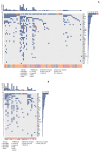Discordance of the PAM50 Intrinsic Subtypes Compared with Immunohistochemistry-Based Surrogate in Breast Cancer Patients: Potential Implication of Genomic Alterations of Discordance
- PMID: 30189722
- PMCID: PMC6473265
- DOI: 10.4143/crt.2018.342
Discordance of the PAM50 Intrinsic Subtypes Compared with Immunohistochemistry-Based Surrogate in Breast Cancer Patients: Potential Implication of Genomic Alterations of Discordance
Abstract
Purpose: We aimed to analyze the discordance between immunohistochemistry (IHC)-based surrogate subtyping and PAM50 intrinsic subtypes and to assess overall survival (OS) according to discordance.
Materials and methods: A total of 607 patients were analyzed. Hormone receptor (HR) expression was evaluated by IHC, and human epidermal growth factor receptor 2 (HER2) expression was analyzed by IHC and/or fluorescence in situ hybridization. PAM50 intrinsic subtypes were determined according to 50 cancer genes using the NanoString nCounter Analysis System. We matched concordant tumor as luminal A and HR+/HER2-, luminal B and HR+/HER2+, HR-/HER2+ and HER2-enriched, and triple-negative breast cancer (TNBC) and normal- or basal-like. We used Ion Ampliseq Cancer Panel v2 was used to identify the genomic alteration related with discordance. The Kaplan-Meier method was used to estimate OS.
Results: In total, 233 patients (38.4%) were discordant between IHC-based subtype and PAM50 intrinsic subtype. Using targeted sequencing, we detected somatic mutation-related discordant breast cancer including the VHL gene in the HR+/HER2- group (31% in concordant group, 0% in discordant group, p=0.03) and the IDH and RET genes (7% vs. 12%, p=0.02 and 0% vs. 25%, p=0.02, respectively) in the TNBC group. Among the luminal A/B patients with a discordant result had significantly worse OS (median OS, 73.6 months vs. not reached; p < 0.001), and among the patients with HR positivity, the basal-like group as determined by PAM50 showed significantly inferior OS compared to other intrinsic subtypes (5-year OS rate, 92.2% vs. 75.6%; p=0.01).
Conclusion: A substantial portion of patients showed discrepancy between IHC subtype and PAM50 intrinsic subtype in our study. The survival analysis demonstrated that current IHC-based classification could mislead the treatment and result in poor outcome. Current guidelines for IHC might be updated accordingly.
Keywords: Breast neoplasms; Immunohistochemistry; PAM50.
Conflict of interest statement
Conflict of interest relevant to this article was not reported.
Figures





References
-
- Torre LA, Bray F, Siegel RL, Ferlay J, Lortet-Tieulent J, Jemal A. Global cancer statistics, 2012. CA Cancer J Clin. 2015;65:87–108. - PubMed
-
- Perou CM, Sorlie T, Eisen MB, van de Rijn M, Jeffrey SS, Rees CA, et al. Molecular portraits of human breast tumours. Nature. 2000;406:747–52. - PubMed
-
- Sotiriou C, Pusztai L. Gene-expression signatures in breast cancer. N Engl J Med. 2009;360:790–800. - PubMed
MeSH terms
Substances
Grants and funding
LinkOut - more resources
Full Text Sources
Other Literature Sources
Medical
Research Materials
Miscellaneous

